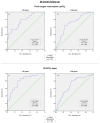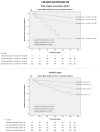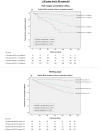Age Differences in Cardiopulmonary Exercise Testing Parameters in Heart Failure with Reduced Ejection Fraction
- PMID: 37763804
- PMCID: PMC10535443
- DOI: 10.3390/medicina59091685
Age Differences in Cardiopulmonary Exercise Testing Parameters in Heart Failure with Reduced Ejection Fraction
Abstract
Background and Objectives: Cardiopulmonary exercise testing (CPET) is a cornerstone of risk stratification in heart failure with reduced ejection fraction (HFrEF). However, there is a paucity of evidence on its predictive power in older patients. The aim of this study was to evaluate the prognostic power of current heart transplantation (HTx) listing criteria in HFrEF stratified according to age groups. Materials and Methods: Consecutive patients with HFrEF undergoing CPET between 2009 and 2018 were followed-up for cardiac death and urgent HTx. Results: CPET was performed in 458 patients with HFrEF. The composite endpoint occurred in 16.8% of patients ≤50 years vs. 14.1% of patients ≥50 years in a 36-month follow-up. Peak VO2 (pVO2), VE/VCO2 slope and percentage of predicted pVO2 were strong independent predictors of outcomes. The International Society for Heart and Lung Transplantation thresholds of pVO2 ≤ 12 mL/kg/min (≤14 if intolerant to β-blockers), VE/VCO2 slope > 35 and percentage of predicted pVO2 ≤ 50% presented a higher overall diagnostic effectiveness in younger patients (≤50 years). Specific thresholds for each age subgroup outperformed the traditional cut-offs. Conclusions: Personalized age-specific thresholds may contribute to an accurate risk stratification in HFrEF. Further studies are needed to address the gap in evidence between younger and older patients.
Keywords: VE/VCO2 slope; age; cardiopulmonary exercise testing; heart failure with reduced ejection fraction; heart transplantation; peak oxygen consumption.
Conflict of interest statement
The authors declare no conflict of interest. The authors declare that no funds, grants, or other support were received during the preparation of this manuscript.
Figures




Similar articles
-
Cardiopulmonary Exercise Testing in the Age of New Heart Failure Therapies: Still a Powerful Tool?Biomedicines. 2023 Aug 6;11(8):2208. doi: 10.3390/biomedicines11082208. Biomedicines. 2023. PMID: 37626705 Free PMC article.
-
Cardiopulmonary Exercise Testing in Patients with Heart Failure: Impact of Gender in Predictive Value for Heart Transplantation Listing.Life (Basel). 2023 Sep 29;13(10):1985. doi: 10.3390/life13101985. Life (Basel). 2023. PMID: 37895367 Free PMC article.
-
Prognostic Value of Cardiopulmonary Exercise Testing in Heart Failure With Reduced, Midrange, and Preserved Ejection Fraction.J Am Heart Assoc. 2017 Oct 31;6(11):e006000. doi: 10.1161/JAHA.117.006000. J Am Heart Assoc. 2017. PMID: 29089342 Free PMC article.
-
The Role of Gas Exchange Variables in Cardiopulmonary Exercise Testing for Risk Stratification and Management of Heart Failure with Reduced Ejection Fraction.Am Heart J. 2018 Aug;202:116-126. doi: 10.1016/j.ahj.2018.05.009. Epub 2018 May 22. Am Heart J. 2018. PMID: 29933148 Review.
-
Cardiopulmonary exercise testing predicts prognosis in amyloid cardiomyopathy: a systematic review and meta-analysis.ESC Heart Fail. 2023 Aug;10(4):2740-2744. doi: 10.1002/ehf2.14406. Epub 2023 Jun 1. ESC Heart Fail. 2023. PMID: 37264762 Free PMC article.
Cited by
-
Early Phase I Cardiac Rehabilitation Integrated with Multidisciplinary Post-Acute Care in Decompensated Heart Failure: Insights from Serial Cardiopulmonary Exercise Testing.Medicina (Kaunas). 2025 Jun 12;61(6):1080. doi: 10.3390/medicina61061080. Medicina (Kaunas). 2025. PMID: 40572770 Free PMC article.
-
Exercise limitations in amyloid cardiomyopathy assessed by cardiopulmonary exercise testing-A multicentre study.ESC Heart Fail. 2025 Apr;12(2):1326-1335. doi: 10.1002/ehf2.15147. Epub 2024 Nov 14. ESC Heart Fail. 2025. PMID: 39543932 Free PMC article.
References
-
- Corra U., Agostoni P.G., Anker S.D., Coats A.J., Crespo Leiro M.G., de Boer R.A., Harjola V.P., Hill L., Lainscak M., Lund L.H., et al. Role of cardiopulmonary exercise testing in clinical stratification in heart failure. A position paper from the Committee on Exercise Physiology and Training of the Heart Failure Association of the European Society of Cardiology. Eur. J. Heart Fail. 2018;20:3–15. doi: 10.1002/ejhf.979. - DOI - PubMed
-
- Chua T.P., Ponikowski P., Harrington D., Anker S.D., Webb-Peploe K., Clark A.L., Poole-Wilson P.A., Coats A.J. Clinical Correlates and Prognostic Significance of the Ventilatory Response to Exercise in Chronic Heart Failure. J. Am. Coll. Cardiol. 1997;29:1585–1590. doi: 10.1016/S0735-1097(97)00078-8. - DOI - PubMed
-
- Francis D.P., Shamim W., Davies L.C., Piepoli M.F., Ponikowski P., Anker S.D., Coats A.J.S. Cardiopulmonary exercise testing for prognosis in chronic heart failure: Continuous and independent prognostic value from VE/VCO2 slope and peak VO2. Eur. Heart J. 2000;21:154–161. doi: 10.1053/euhj.1999.1863. - DOI - PubMed
MeSH terms
LinkOut - more resources
Full Text Sources
Medical
Miscellaneous

